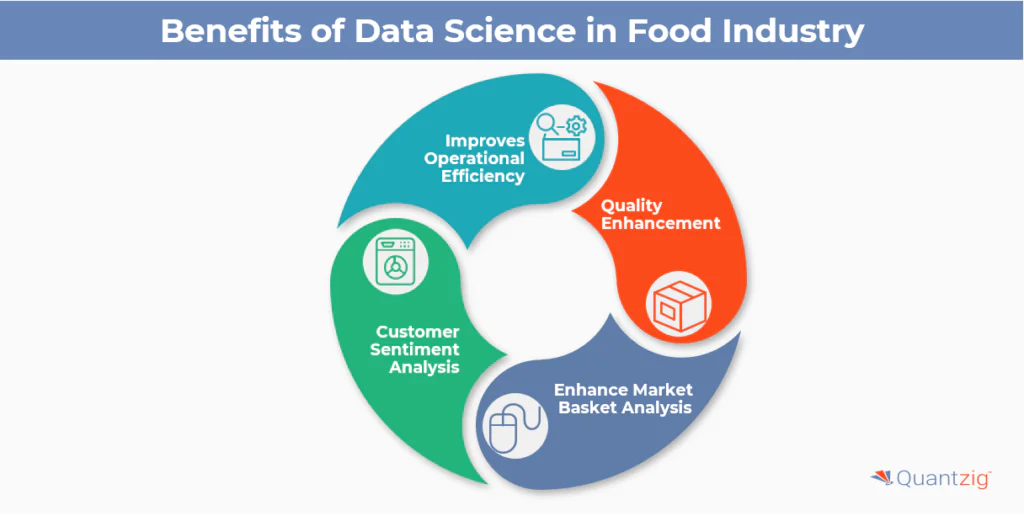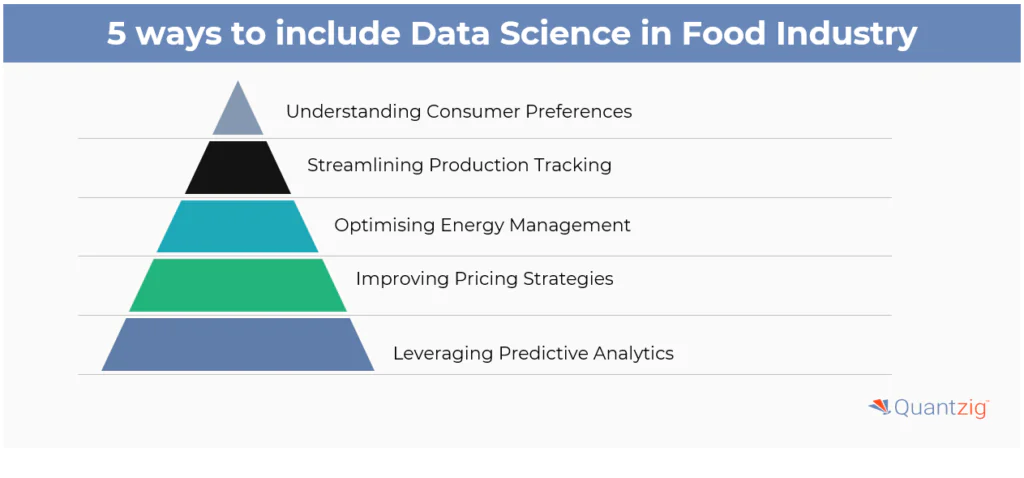Written by: Medha Banerjee
Table of Contents
Introduction to Data Science in Food Industry
In the food industry, data science and machine learning play a crucial role in addressing the challenges posed by changing consumer demands and regulatory requirements. Companies are leveraging data science to enhance efficiency and gain insights into customers’ preferences. Machine learning algorithms help in predicting the lifespan of products, especially temperature-sensitive items, by monitoring and optimizing temperature conditions. Additionally, data science aids in weather prediction reports, which are valuable for farmers and restaurant owners to manage soil nutrients and make informed decisions based on predictive algorithms. By incorporating these keywords, we can highlight the relevance of data science in various aspects of the food industry.
Data science is fundamentally revolutionizing the way food is manufactured. Companies in the food industry are actively tapping into data science to bring about improvements in inventory management, enhance quality control methods, and meet growing consumer demands. In this article, we have discussed a few benefits of data science in the food industry that can help companies to improve business operations and meet customer satisfaction levels.
Book a demo to experience the meaningful insights we derive from data through our analytical tools and platform capabilities. Schedule a demo today!
Request a Free DemoOptimize Marketing Efforts with artificial intelligence food industry
The food and beverage industry requires companies to stay up-to-date with the latest technology and trends, driving a strong demand for data science and data analytics. Food service operators leverage market data analytics to gain insights into pricing details, audience preferences, and emerging market trends. This empowers them to make well-informed business decisions.
Food and beverage manufacturers benefit extensively from digital transformation by adopting Industry 4.0 practices. These enable them to gain insights from daily operations and production processes, driving improvements throughout their entire business.
Enterprise systems enable organizations to digitally connect various functions, allowing employees and executives to link to strategic and tactical goals. This approach helps companies stay competitive by enhancing efficiency and providing actionable data.
Optimizing Marketing Efforts with Food and Beverage Data Analytics
Data-driven product promotion
Food and beverage companies use data analytics, including express analytics and machine learning solutions, to analyze consumer patterns and target marketing campaigns more effectively.
For instance, if products like cinnamon rolls and bagels are gaining popularity, businesses can design personalized marketing efforts with promotions such as coupons and special deals to boost sales.
Enhancing digital marketing strategies
By reviewing previous purchases and customer traffic patterns, businesses can use personalized marketing approaches to promote related products and increase the frequency of purchases.
For example, beverage businesses could target tea lovers with advertisements for new tea varieties, resulting in increased sales and customer engagement.
Personalization and audience segmentation
Currently, 73% of consumers expect companies they interact with to understand their needs and preferences. Food and beverage companies use data science and data analytics to segment their audience and personalize marketing strategies for different groups. The goal of this approach is to make marketing content more relevant to the target audience, resulting in higher customer response rates.
Improving marketing ROI
By analyzing which products generate more impressions and clicks, or which customers are purchasing them, companies can allocate marketing resources more effectively to maximize ROI.
This strategy helps streamline efforts and improve the accuracy of marketing techniques.
Optimizing inventory management
Using data analytics, food and beverage companies can monitor inventory levels to match market trends and manage inventory more efficiently. By analyzing data on menu choices and customer traffic patterns, companies can make data-driven decisions about which items to stock and how much to produce.
Enhancing delivery procedures
Data-driven insights into customer patterns help companies optimize delivery procedures to meet demand and provide a better customer experience. With the right analytics tools, companies can make strategic adjustments to improve delivery times, meet customer preferences, and streamline their operations.
Experience the advantages firsthand by testing a customized complimentary pilot designed to address your specific requirements. Pilot studies are non-committal in nature.
Request a free pilotBenefits of Data Analytics in the Food Industry

Improves Operational Efficiency
Data science techniques can help food manufacturers to analyze the impact of market trends on stock consumption. Also, it can help in analyzing the effect of temperature on the quality of food in real-time. Furthermore, data science in food industry is helping companies to analyze customer behavior and buying habits using various algorithms. Data science techniques can also help food manufacturing companies to analyze customer shopping history data that can further help them in personalization.
Helps in Customer Sentiment Analysis
Data science in food industry can help companies in monitoring customer sentiments over social media platforms. By leveraging the use of techniques such as natural language processing, companies in the food industry can categorize customer feedback into positive, negative and neutral. This can further help in analyzing customer sentiments on the scale. Additionally, by analyzing negative feedback, companies can take preventive measures to improve customer service and satisfaction.
Aids in Quality Enhancement
For brands in the food industry, maintaining the same quality of packaging is quite a challenging task. Apart from the proper measurement of ingredients, it also depends on the quality and storage of the ingredients. Data science in food industry can help companies to analyze such factors and predict their impact on the quality of the food. Furthermore, data science tools and techniques can also help analyze factors that affect the quality of packaged food. By gaining insights from such analysis, companies can easily understand the pain points and work on the improvement of customer service.
Enhances Market Basket Analysis Techniques
Data science in the food industry can help companies in market basket analysis through which they can predict frequently purchased items. By gaining valuable insights from this analysis, food manufacturers and retailers can improve their marketing campaigns and strategies. Furthermore, data science in the food industry can be leveraged to improve cross-selling and up-selling strategies.
Get started with your complimentary trial today and delve into our platform without any obligations. Explore our wide range of customized, consumption driven analytical solutions services built across the analytical maturity levels.
Start your free trial5 Ways to Apply Data Analytics in the Food and Beverage Industry
Data analytics in the food and beverage industry show that customized marketing is the most effective way to capitalize on new opportunities. By leveraging consumer feedback and food insights, companies can understand market fluctuations, identify customer demands, and create impactful strategies to meet those needs.
Let’s examine how food and beverage businesses use data analytics to enhance decision-making:

Understanding consumer preferences
Understanding what consumers prefer is essential for business success. Food and beverage businesses gather data on customer choices for food and drinks, the frequency of orders, and preferred pricing. Advanced data analytics helps companies collect this data through customer feedback, changing customer behavior, and point-of-sale data analysis.
For instance, businesses can review the top 10 trending and best-selling products. Comparing this data with the past 13 months can offer insights into customer dislikes and preferences. This data helps businesses refine their current product lines, create new offerings that align with customer preferences, and boost customer satisfaction.
Moreover, data analytics enables businesses to identify customers who have reduced their purchases in the last 13 weeks. This could signal potential churn and indicate which products customers are losing interest in and which ones they favor.
Streamlining production tracking
Data analytics simplifies production tracking for food and beverage companies. By analyzing product-level data, businesses can identify opportunities for improvement and inefficiencies in internal processes. For instance, data analytics can reveal current order levels, the number of items ready for delivery, and which department has the longest order processing times.
Based on this data, companies can make informed decisions about delivery schedules, staffing, and inventory management. Our order monitoring system provides real-time updates on every step of the approval process. Whether you’re tracking a specific product or customer order, our system keeps you informed.
You can easily access order statuses, whether they’re ready for delivery or being handled by your customer support team. This level of transparency ensures you always know the status of customer orders, enabling you to make necessary decisions quickly.
Optimising energy management
Food and beverage companies leverage data analytics to identify which items are consistently ordered at specific times of the day, allowing them to adjust staffing levels accordingly.
A dashboard with data on order quantities by date offers insights into energy usage patterns. By monitoring energy consumption across different days, businesses can determine when to reduce energy usage to minimize costs. This data-driven approach allows businesses to cut unnecessary expenses during slow periods and develop more effective energy management plans.
Improving pricing strategies
Pricing is a critical factor for food and beverage companies, and data analytics enables businesses to analyze pricing information and refine strategies. Recent technology allows companies to quickly identify promotional opportunities for all products.
By evaluating pricing data, businesses can identify their most cost-effective items and adjust pricing strategies accordingly. They can assess data on the most successful promotions and modify their marketing strategies to maximize ROI. Automating this process saves time and money.
Leveraging predictive analytics
Food and beverage businesses can use data analytics for predictive insights. By examining historical data, predictive analytics can identify trends and patterns that forecast future behavior.
For example, companies use predictive analytics to forecast inflation rates, adjust pricing plans, and improve production processes.
Predictive analytics for restaurants can help businesses stay on top of emerging trends and make informed decisions about promotions and offerings. AI can monitor market conditions and identify potential risks or opportunities.
Ultimately, food data analytics can be utilized by companies to create predictive models and strategies for potential market shifts. Using AI-driven predictive models, businesses can develop effective strategies to remain competitive and agile in a dynamic market.
Conclusion to data science and food industry
By disclosing the components, origins, and methods employed in producing your goods, you enable your customers to comprehend the contents of the products. Utilizing data to demonstrate to customers that your supply chain processes are sustainable and health-conscious can instill confidence in the excellence of your product.
Although data science may have its origins in the technology sector, analyzing data is a significant practice in the food industry. Whether it involves leveraging data for crafting a successful marketing campaign or presenting a visual representation of your supply chain to consumers, data science is pivotal in your production and sales processes.




